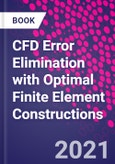CFD Error Elimination with Optimal Finite Element Constructions contains the theoretical basis, equation development, and algorithm development steps needed to generate a significantly improved AD methodology for CFD users and code developers worldwide. By informing users of the presence of these errors and the possibility that the solution they are obtaining could have embedded errors, this book aims to improve the accuracy of research carried out across fluid mechanics, particularly in turbulence and heat transfer.
In general, the field of computational fluid dynamics (CFD) involves the numerical solution of the Navier Stokes equations, the alternate compressible form, and the required constitutive equations to close the solution. These equations are inherently unstable and require some form of artificial dissipation (AD) in order to stabilize the numerical solution. One distinguishing factor in all CFD computer software is how they handle this AD and how accurately the code results compare to known solutions, i.e., validation. The accuracy of all existing methods can be improved and is nowhere near perfect.
Table of Contents
1. Introduction to CFD 2. A brief history of CFD legacy code creation 3. Navier-Stokes PDE Statements 4. NS spatial discretization O(h2) truncation error (TE) 5. RaNS/LES spatial discretization O(h2) TE annihilation 6. NS temporal/phase discretization O(?t3, mp) TE annihilation 7. Radiation, Stefan-Boltzmann, radiosity, efficiency 8. Weak form theory, attributes, O(h4, m4, ?t4) CFD algorithms/codes 9. Space filtered NS PDE system closed modeling free 10. Filtered NS (FaNS) theory rendered bounded domain well-posed 11. Validation, FaNS theory laminar dominated predictions Re < 4000 12. FaNS theory periodic, multi-scale, transitional prediction, Re ? 12,000








